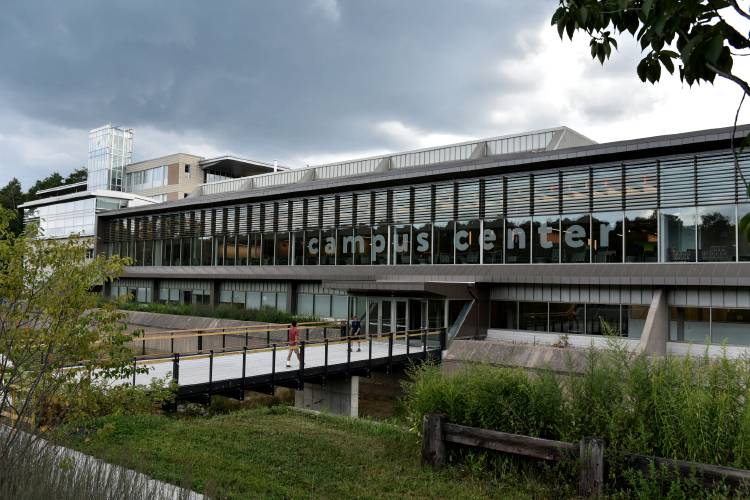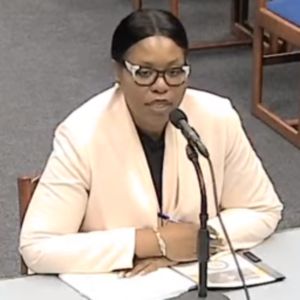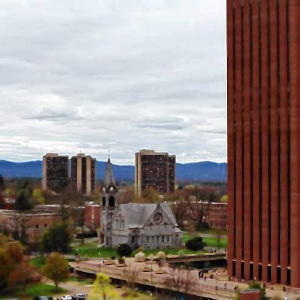Report flags equity, income in free college debate

Holyoke Community College. FILE PHOTO
| Published: 04-13-2024 4:01 PM |
BOSTON — Moderate-income white students could gain the most under a proposal that top Senate Democrats are weighing to make community college free for all Massachusetts residents, according to a report, which urges lawmakers to make adjustments with the goal of providing the most financial support to the lowest-income Bay Staters.
Senate President Karen Spilka hinted in January that free community college funding is likely to appear in the Senate’s version of the fiscal year 2025 budget, during a press conference where she and other senators rolled out a Massachusetts Association of Community Colleges’ draft report on how the state could move toward universal tuition-free college.
The MACC report, conducted by Boston Consulting Group and funded by last year’s state budget, estimated that making community college free would cost the state about $170 million annually. The final version of that report is due by the end of April to the Legislature, and will likely serve as a blueprint for lawmakers’ plans — the Senate budget is due out in May.
“The proposal, while broad in its appeal and commendable for its intention for universal access, inadvertently risks perpetuating and possibly exacerbating existing racial and economic disparities in educational access and success,” says the report by higher education nonprofit Hildreth Institute, which was released before the House Ways and Means Committee’s annual budget bill.
The MACC proposal compares financing models that lawmakers could consider to pay for free community college, suggesting a “preferred” model, which would provide more funding for low-income students than a “last-dollar” model like MassReconnect, the new state program that holds the promise of free community college for students 25 and older.
Under this “preferred” “middle-dollar” model, the Hildreth Institute report says for each dollar allocated to a student of color, a white student would receive $1.50. White students make up 42% of the community college population, the report said, but would total 70% of those receiving the highest level of tuition-free grants.
“Our analysis reveals that while the tuition-free community college initiative is a commendable step towards broader educational accessibility, it inadvertently favors students from moderate to middle-income backgrounds,” said Dr. Bahar Akman Imboden, the report’s lead author. “While these students do encounter financial hurdles, their resources and support systems often enable them to overcome these challenges, strengthening their chances of persisting and graduating. In stark contrast, lower-income students receive significantly inadequate support, struggling against a wider array of financial barriers that hinder their academic success. This imbalance challenges the core principle of equity and diminishes the initiative’s potential to facilitate meaningful change for those who need it most.”
In MACC’s recommended model, Pell Grant-eligible students (who display exceptional financial need and who make up about 60% of the community college population) would receive about $75 million of the program’s total funding. This “middle-dollar” plan provides more funding to Pell-eligible students than a “last-dollar” model, which only provides 25% of funding to Pell-eligible students.
Article continues after...
Yesterday's Most Read Articles
 The Iron Horse rides again: The storied Northampton club will reopen at last, May 15
The Iron Horse rides again: The storied Northampton club will reopen at last, May 15
 Homeless camp in Northampton ordered to disperse
Homeless camp in Northampton ordered to disperse
 Authorities ID victim in Greenfield slaying
Authorities ID victim in Greenfield slaying
 $100,000 theft: Granby Police seek help in ID’ing 3 who used dump truck to steal cash from ATM
$100,000 theft: Granby Police seek help in ID’ing 3 who used dump truck to steal cash from ATM
 UMass football: Spring Game closes one chapter for Minutemen, 2024 season fast approaching
UMass football: Spring Game closes one chapter for Minutemen, 2024 season fast approaching
 Final pick for Amherst regional superintendent, from Virgin Islands, aims to ‘lead with love’
Final pick for Amherst regional superintendent, from Virgin Islands, aims to ‘lead with love’
Spilka called the MACC report a “menu” to choose from when considering a program for the Senate to take up. Gov. Maura Healey and top House Democrats did not include an expansion of free community college in their respective budget bills.
The institute warns that “middle-dollar” or “last-dollar” models help close gaps for students who receive less financial aid — who tend to be higher income and white — than it does provide help for lower-income students who are already receiving significant financial help.
This is because these programs are focused on the cost of tuition and books, and not the full “cost of attendance,” a term used to describe the total amount it costs to go to college each year, including housing and transportation.
“The report identifies that the plan’s focus on direct educational costs — such as tuition, fees, books, and supplies — also overlooks the substantial indirect costs — such as room, board, and transportation — that disproportionately burden low-income students who face more severe and varied challenges in accessing and completing higher education,” an institute press release on the report says.
Imboden, of the Hildreth Institute, said the tuition-free community college initiative “inadvertently” would give more help to students from moderate and middle-income backgrounds.
“We unequivocally agree with the policy brief that the cost of college goes far beyond just tuition fees, books and supplies, in particular for lower income students,” said Nate Mackinnon, executive director of the Massachusetts Association of Community Colleges. “Cost of living — the cost of paying rent and putting food on the table and getting to classes — disproportionately impacts lower income students.”
Mackinnon said the total cost of attending community college in Massachusetts is around $21,000, even though average tuition fees are closer to $6,800. This is why MACC recommended a “menu” of options for the Legislature to choose from, he said.
“We still have much to discuss about which model and which policy choices make sense for Massachusetts, but we are pleased to see that the prevailing proposal is affordable, it will increase attendance, and it will improve outcomes,” Spilka said at a press conference about the MACC report in January. “Not only that, but it centers equity, with the vast majority of funding, 70 percent, going to students from families who make less than $100,000.”
The most comprehensive model in the MACC report recommends putting forward the $21,000 average total cost of attendance for all community college students. Everyone would get tuition covered under this plan, and lower-income students would also get a stipend to offset the cost of living.
However, this model would cost the state an estimated $280 million. The preferred plan MACC recommended would cost the state $170 million to cover tuition and supplies for all students, as well as a more modest stipend for some with greater needs.
“What the middle-dollar model does, from our perspective, is try to not let perfect be the enemy of the good,” Mackinnon said. “If the goal is to get more students to a degree, the more money we can give lower-income students the better. And we completely agree with that. However, we also recognize that we’re trying to put something together that has the possibility of becoming a reality with the fiscal constraints we have in the commonwealth.”
Mackinnon said MACC agrees with a recommendation in the Hildreth Institute report to go forward with the middle-dollar model, with a commitment to increasing the stipend for lower-income students in the future.
However, he warned against another recommendation Hildreth made to create an income limit for the program.
“Introducing an income limit could target the larger stipend towards those who need it most, thereby offsetting the cost,” the report says. “A commitment to move towards universality over time could be made, ensuring that the program progressively aligns with its original inclusive vision.”
It adds that this system could implement targeted aid on a sliding scale prioritizing economically disadvantaged students.
“By significantly boosting financial aid for those who need it most, the program would achieve more than just a rise in enrollment numbers. It would guarantee that all students, irrespective of their race or income, have the opportunity not only to enroll but also to persist and successfully complete their degrees,” Imboden said.
Mackinnon, however, argued that the program would lose impact if it were not universal.
Every one of Massachusetts’ 15 community colleges saw enrollment increases in the past year following the passage of MassReconnect, a program Healey pushed for in last year’s budget to make community college free for everyone older than 25 who did not previously have a college degree. That program cost the state $20 million in fiscal 2024, covering last-dollar costs that were not already paid for by federal or state financial aid.
Mackinnon said many of the new enrollees could have attended college for free prior to the passage of MassReconnect through federal and state financial aid programs, but the complexity of the financial aid system was a barrier to entry.
“They came because they heard it was free,” he said, adding that encouraging students to engage with the complicated system of applying for financial aid “didn’t translate.”
“What did translate, is telling students that if they’re 25 or older, and they don’t have a degree, community college is free,” Mckinnon said.
Making community college free for all is a simple message, he said, and one that would lead to higher enrollment across income brackets.
“From our perspective, the universality of this is the most important aspect,” he said.

 Authorities ID victim in Greenfield slaying
Authorities ID victim in Greenfield slaying  Federal probe targets UMass response to anti-Arab incidents
Federal probe targets UMass response to anti-Arab incidents Locking up carbon for good: Easthampton inventor’s CO2 removal system turns biomass into biochar
Locking up carbon for good: Easthampton inventor’s CO2 removal system turns biomass into biochar William Strickland, a longtime civil rights activist, scholar and friend of Malcolm X, has died
William Strickland, a longtime civil rights activist, scholar and friend of Malcolm X, has died
